

Project «Voices of Jewish settlements. Minsk region.»פיתוח קשרי התרבות בין העמים של ישראל ובלרוס
|
|---|
Website search |
|
MainNew publicationsContactsSite mapVitebsk regionMogilev regionMinsk region |
RECOLLECTIONS BY PREWAR RESIDENTS OF SELIBA SHTETL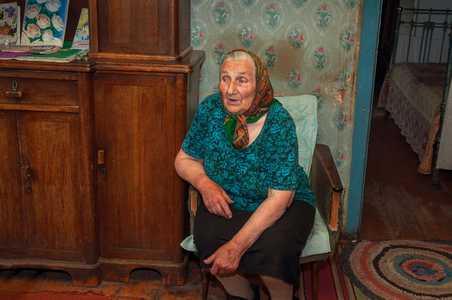 Raisa Aleksandrovna Parkalova.
Raisa Aleksandrovna Parkalova.
Raisa Aleksandrovna Parkalova, born in 1926 I was born in Seliba, in the village of Luchnoi Most to be more precise. The village was inhabited mostly by families with the surname of Borisevich, so the place is now also known as Borisy. Half of Seliba was Jewish. The village was large, only Jewish houses counted to fifty or sixty. 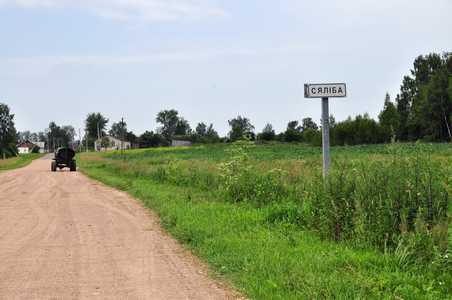 Seliba.
Seliba.
Before the war I completed eight years of studies at the Russian school in Seliba. We studied together with Jewish children. When I went to study, there was also a Jewish school in Seliba, but many children transferred to the Russian school. In the late 1930s the Jewish school was closed. There were so many pupils in the Russian school that a small wooden building had no space enough. The headmaster was a Jew, Solomon Moiseevich Fanberg. In the second grade I was taught by Raisa Borisovna Shapiro (Barshai), in the third grade by Raisa Borisovna Pevzner, in the fourth grade by old teacher Dubrovsky, who had been repressed before the war, and in the early 1990s. rehabilitated. There was another teacher, Hana Rubinchik. Lev Moiseevich Grubshtein taught mathematics (he survived, after the war he returned to Seliba and we worked together at the school). In the fifth grade our teacher was Ella Samuilovna (Moiseevna) Generson. Her father was the headmaster of the Jewish school. When the school was closed, he went to work in a primary school in the village of Putki. Children from the Polish school in the village of Barsuki moved to study at our school. In 1941, the first group of pupils completed a ten-year course of the academic studies in Seliba. Many Jews studied at our school. I studied together with Tsilya Israilevna Klyuch, Boris Karasik, Yasha Karasik, Boris Elentuh, Nechama Margolina, Raya Levina. Sonia Girshick studied one year before me. Her mother was an excellent cook, lived to 100 years and read books and counted very well until the end of her life. After the war, Sonia Girshick was our Pioneer leader at school. She was evacuated to Karaganda, and is now buried at our cemetery. In 1938, there was a large fire in Seliba. Sparks from a circular saw started it. When the workers were having lunch, the sawmill caught fire. There was oil in barrels, it exploded, and a lot of houses burned down. I remember the fire very well. I was at school then. We were at the lesson of German when someone shouted that Seliba was burning and we all got out of the school. The village was burning at both ends. Many villagers, having lost their houses, left the shtetl after the fire. There were two synagogues in Seliba. They were beautiful brick buildings. One of them had been transformed into a club before the war, the other into a bakery. These buildings are no longer here. The Jewish and Belarusian houses looked almost the same, except that the Jewish were slightly higher. The houses had two entrances: the street door and the back entrance from the yard. 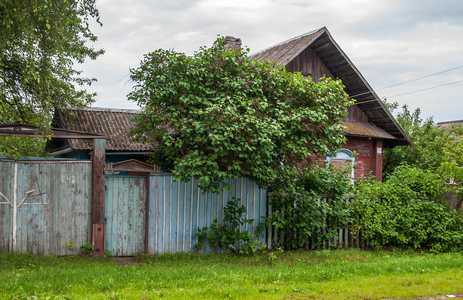
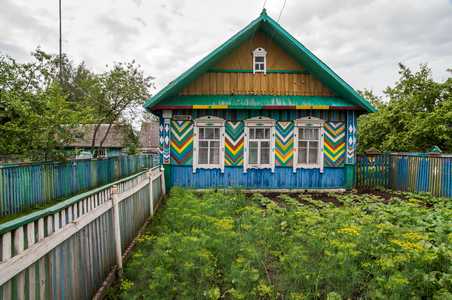 Places where the synagogues were located, Seliba.
Places where the synagogues were located, Seliba.
The village Zhalino also had a lot of Jewish houses, and there was a synagogue. Before the war it had been made into a club. Ruined, it is still there, while during the war it remained absolutely untouched, even the window glass was unbroken. There were good houses in the shtetl, a lot of shops. Now, you’ll find neither a shoemaker nor a stove-maker, but there used to be many. The shop was run by Simson. Shimshel worked in the state-owned store. One-legged Honya kept a shop where they sold only wine and vodka. One side of the house was a shop and the other was Honya’s home where he lived with his mother and helper. Dr. Hertzel Plaksa occupied a half of the house, and the other half was a village consumers society. There was no Jew who mastered no craft. They were skilled at everything. Before the war, the Jews of Seliba were shoemakers, tailors, stove-makers, junk-dealers. There were no problems with clothes or shoes. What beautiful boots and high-heeled shoes they made! Haika Rubinchik, Girshick, Levin were tailors. I had my clothes made by Haika. The mute tailor, Artya, and his wife Gita made good pants. The tailors came straight home with a sewing-machine and altered clothes. The stoves that Jews built before the war, still serve the neighbors. Boris Elentuh and Khanin were stove-makers. Iser swept chimneys, his house is still in Seliba. Before the war, a Jew was making a stove in our house and stayed overnight. He was praying and put something on his head, twisted something on his hands. Later, my little brother, Kolya, who saw the Jew, imitated him and put a shoe on his head. Yankel’s wife, Goda Katznelson, and Levin were hairdressers. Gilka took leather. His brother Elya lived nearby. His house burned down during the war. Motka Rubinchik kept a pharmacy in the house. The house was divided into two parts. Pharmacist Reihlin worked in the pharmacy. He was evacuated, and after the war worked at a pharmacy in Berezino. He was a friend of my dad, helped with medications. I was at his funeral. He was buried like a Christian in a coffin. In the village Jews were buried in a different way, clothed in white linen. The graves were dug out by the Russians. I remember burying Yankel, Geika’s son, who drowned during haying time. He was lying on the floor covered in a winding sheet, and the grave was lined with wooden planks. There was no wake. People just prayed. I also remember the funeral in the Loshakov family. Their young son, a student, died. At that time young people went to study to become engineers. I studied with his sister in the sixth grade, and we were watching the funeral from a window. The dead body was on the floor in a white sack. Only the body was in a sack. There was no coffin at the cemetery, only wooden boards. The burial process was held by the Russian men. When the coffin was lowered, all the Jews went away. After the war, people were buried in coffins. 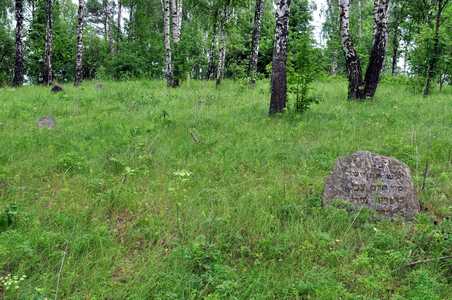
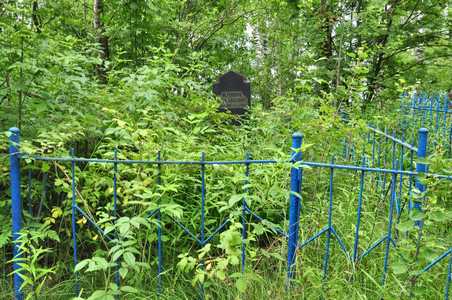
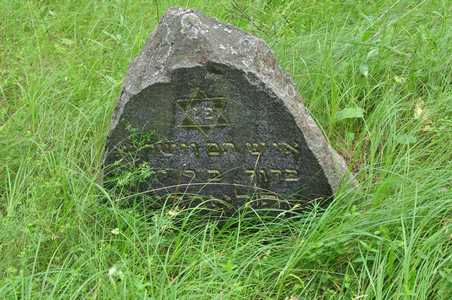 Jewish cemetery, Seliba.
Jewish cemetery, Seliba.
We visited each other’s homes. I remember that I lived next to Yudas, a Jewish woman. Her daughter Franya invited us, children, to her birthday party. We were treated to tea, cake “lekah”, and jam. It was delicious and unusual. The Jews were very good at baking, made jam from cherries, red currants and other berries. The Russians didn’t make jam, they didn’t even know what it was. The Jews spoke Jewish language and quite good Russian, but with an accent. My father spoke good Yiddish, I also spoke the Hebrew language, like many of us. When I was young I knew the entire Hebrew alphabet, I could write, but now I’ve forgotten everything. We all had good vegetable gardens. There were rich Jews and poor. Mainly the poor joined the farm. In 1929, a Jewish collective farm “Ardus” was established, but before the war it had already merged with the collective farm named after Kalinin. Not only the Jews joined the farm, but also our locals. Our part of Seliba was called “red”, and the other part of Seliba was “white”. My father worked there as a foreman. There were many Jewish farmers. Rokha, Sonia’s mother, and tailor Girshick’s daughter (Girshick worked as a watchman at the farm) worked for the farm. She was very good at baking, and was very literate. Rokha was a Stakhanovite, an extremely productive and hard-working worker, had a lot of books, works by Sholem Aleichem. 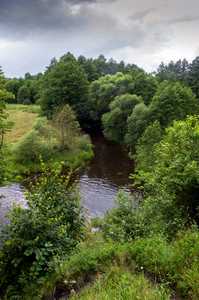 The Usa River
The Usa Riverin Bogushevichi region. Before the war the Jews ate only “kosher”. They ate on Pesach from special dishes. They didn’t eat salo (cured pork meat), pork, veal, and beef. There were butchers, and people took poultry to them for slaughter. There lived ‘reznik’ (butcher) Girsha. He had one finger cut off. The Jews kept cows and pigs, but they ate no pork. Pork was for sale. They cooked very tasty dishes. From the Jewish holidays I remember Passover. People baked a lot of matzah, large round thin pieces of bread, two weeks before the holiday. The Russians helped with baking. Bread was not eaten for a week before Passover. The table was covered with a tablecloth. There was a saying: “Bread under the table. Matzah on the table.” They cooked very delicious dishes from matzah. Matzah was kept in suspended large white tablecloths. The boys brought matzah to school and treated us, while we treated them to apples and pears. Many Jews had gardens. But our gardens were somewhat bigger. I remember tailor Girshick, Sonya's father, shoemaker Levin, shop-keeper Zyama Klyuch. I remember Haya Rodova. She had a big house. It was dismantled and made into a bakery. There lived physician Hertz, people called him Gerchik. One part of his house was an accountant’s office. Tailor Artya and his wife Gita lived nearby. Before the war, we stood in a queue to buy fabric. They sold only 10 meters to a person. At the beginning of the war all village stores were broken and everything was taken away. In houses everything was plundered. There were a lot of prayer books, parchment scrolls, and they all were stolen. During the war we drew maps on the parchment with soot. Someone from Seliba lads brought it. Nothing remained. During the war my brother (he finished 10 years at school just before the war), and sister were partisans. My mother, father, and other 8 relatives were arrested by the Germans for collaboration with the partisans. Luckily, there was a Russian interpreter who was connected with the partisans, and he was translating the interrogation. The policemen said something, and he translated something different to the Germans. There wasn’t a day when we didn’t hide from raids and round-ups in the woods. Several people were taken to a concentration camp in Mogilev. In Seliba there were a lot of local policemen. Only 10 Jewish families managed to get evacuated. The rest of the Jews worked for the collective farm named after Kalinin, took in the harvest. When they dug out potatoes in autumn, probably in September, the policemen arrived and took them to Bogushevichi, where they were shot. I lived in Seliba during the war. When the war broke out, the retreating Soviet soldiers told us to leave because there would be the defense line near our village. Many trenches were dug out. We all went to the Klichev region, but soon returned. The village was bombed, but people were not injured; only the cattle and a dog were killed. There was a lot of weapon left. They find it even today. Even the bombs dropped from aircraft, hitting into the swamp, didn’t explode. At the beginning of the occupation the Germans forced us to collect them. When the Germans occupied the first defense line and came to Seliba, they took 6 or 10 strongest young Jewish men and shot. Their bodies were dropped into a pit and covered with soil. Now you won’t find this place. There were two of my brother’s classmates, who had just graduated from school. The lads were reburied at the cemetery in the 1950s. 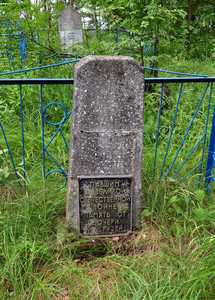 Monument at
Monument atthe Jewish cemetery, Seliba, on the site where the Jewish girls, tourtured by the Germans, were reburied. They caught 5 or 6 most beautiful young Jewish girls: Manya, Vlada, Yankel’s daughter Anna, Ara’s daughter Doba and her sister. They were taken across the river towards the village of Yadlina and tortured. Then the locals buried them. Among them was Manya Margolina, Leikova, there also were two of my classmates and friends - Genya Klyuch and Raya Karasik. After the war, we were shown the place where they had been buried. Grunya Loshak was also killed across the river during the war. There was no place for hiding. There were no partisans. Now, as I’m walking along the street, I see that it could be easy to hide, and at that time there was only an open field. Genya Klyuch and my sister finished school in Berezino. Before the war she had already graduated from college and had been working in Osipovichi as a dentist. When the war broke out, Ara and his wife went away. His mother remained in the village, so Genya came to her grandmother in Osipovich on foot. The grandmother was also shot. Two men, the brothers, one of them was named Geika, and a woman, Haika Sokharava remained alive during the shooting. In August 1941, all the Jews who remained in the village were driven to Bogushevichi. Some of them were killed in Berezino. The Jews were convoyed by policemen, who knew where people lived and committed atrocities worse than the Germans. In Bogushevichi the Jews were shot and dumped in a specially prepared pit. I heard that during the shooting Haika Sokharava remained alive, she fell into a pit and later got out, and two brothers - Gilka and Elya. Later Haika told us that when the shooting began, a dead body fell on her and pushed her into the pit. The brothers were wounded but climbed out of the pit. They were hiding in the woods, later in a partisan unit. I didn’t know about anyone hiding Jews, those who escaped joined the partisans. There was a boy who was hiding, I forgot his name. He was 15 years old or younger. He ran away and asked us to stay in our village. We gave him food for two months, warm clothes. It happened after the shooting. We dug out trench shelters behind the swamp, and were hiding there. We took the boy to the trench shelter. Later he asked to join the partisans. By that time we had already found out that our former village council chairman, later Communist District Committee Secretary, Anton Moiseevich Baranov, headed a partisan unit in the Klichev district and sent the boy to him. Stepan Syrokvashko, our local policeman, nicknamed Sukhoruky, caught him up near the village of Naborok and killed. Stepan was shot, our militia caught him after the war. There lived Mariika Chaika in our village. She had many daughters. One of her daughters, Nasta, was said to have dated a Jew and given birth to a child. Our policemen told the story to the Germans. The woman and her child were killed, the house was set on fire. Their dead bodies were drawn out of the fire by the neighbors. Several other houses of partisan families were burnt down. The Romanovs’ house and several other houses burned down from bombing. 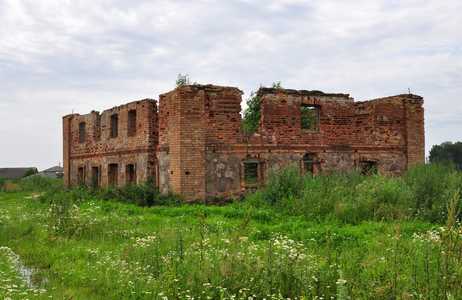 Ruins of the Jewish steam powered mill
Ruins of the Jewish steam powered millnear the cemetery. There was an old Boruhova mill. It worked during the war and the partisans ground grain. They would go from village to village to order grain and crackers. Then in the afternoon they picked up and in the evening or early in the morning they came to us in the woods and ground the grain at the mill. The firewood for the steam mill was taken in empty Jewish houses, and the houses themselves were dismantled. I still find holes where the partisans were hiding grain. Together with the partisans I took the sacks with flour on carts to the Usakinskie woods. After the war Ara Klyuch, Genya’s father, returned from evacuation. He learned about the fate of his tortured daughter. Ara dug up the remains of the dead bodies and reburied them at the cemetery in Seliba. Before the war Ara went from village to village to take photos of small children. He also worked as a purchaser. The cemetery is also the burial place for the Jews who died after the war, those who remained to live in Seliba. My father saved books in the ground and photos in a bottle buried in the ground. After the war, they dug up the bottle with pictures and there, in the photograph of the graduates, was Genia. Ara then photographed the photo of his daughter. Now, these photos are lost. We had five or six policemen. I disclosed one policeman after the war. His name was Kotik, nickname “Cat”, and he was at school with me. He told everyone that he was at the front line. Kotik and Shmarovsky, also a policeman, were arrested and taken away after the war. We heard nothing about them. Many people were shot in Seliba as partisans. Our Seliba was called a “partisan headquarters.” My parents were also arrested. We bought them out of the policemen in exchange for milk and honey. Many people were killed before the retreat. We spent nights in the dugouts. A lad from the neighboring village told us that the Germans forced everyone into one house. We, the girls, ran away to the swamp. The Germans were following us. Suddenly I heard the familiar voice: “Girls, go home! The red forces are in Seliba!” Even today, when I see the German military clothing, I feel uneasy. After the war many front-line soldiers came back from the evacuation: the Girshicks with six children, the Karasik family, but didn’t stay long. People sold their houses. Many Jews later went to America, Israel. Boris Karasik came from America. Few Jewish houses remained, only those occupied by the refugees during the war. During the war Jewish homes were dismantled for firewood by the policemen. 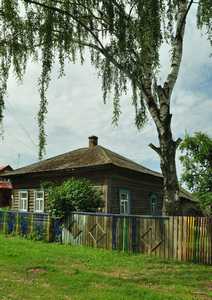
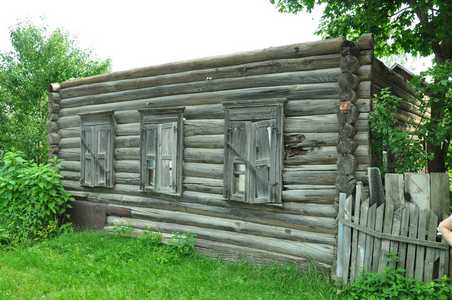 Old Jewish houses on Tsentralnaya Street, Seliba.
Old Jewish houses on Tsentralnaya Street, Seliba.
Teacher Grubshtein was evacuated with his daughter Sonya and his pregnant wife Daria. On the way to Lisicheno Daria gave birth to a child, and they all got to Nesyaty. They boarded a train and left. After the war the family returned and lived here. Grubshtein continued working as a teacher after the war. Rokha’s daughter, Sonya, finished eight grades at school before the war. During the war she was evacuated to Karaganda. She worked at the plant, was awarded a medal for her work. After the war she worked as a Pioneer leader at school, studied at the Teacher Training College, then gave birth to a daughter, worked as a secretary of the Komsomol organization, in the village council, as a village council chairman. She didn’t celebrate the Jewish holidays, didn’t observe the Jewish customs. However, when Sonia was already retired, she treated me to matzah from a big box. People didn’t bake matzah at that time. That box was sent from France. 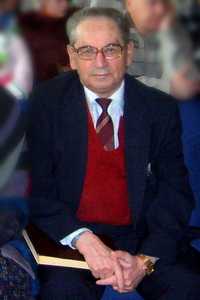 Yefim Timofeevich
Yefim TimofeevichGalper. Recollections by Yefim Timofeevich Galper (1933 - 2008) I was born on August 17, 1933, in Mogilev. I lived there before the war and after the war. I came from a very simple family. My parents were from Berezinsky district, Minsk region. There is a Jewish shtetl of Seliba. Many famous people were born there. My mother was Haya Elievna Farber, born in 1908. She had 9 brothers and sisters. My grandfather owned a shop. He died in 1939, before the war. We moved to Mogilev in 1933. In spite of the fact that my grandfather sold fabric, everyone in the family had only one dress. The family was very poor, barely able to make ends meet. Two brothers of my mother were killed at the front at the beginning of the war. One sister was killed in Minsk during the bombing. Another sister, Rakhil, also lived in Mogilev and was married to a party worker named Levit. His name was Ephraim. He was left in Mogilev for the organization of the underground, and at the beginning of the occupation, he was disclosed to the Nazis by the neighbors. His daughter and son lived in Minsk, emigrated to the United States in 1980, and now live in New York. They are retired. 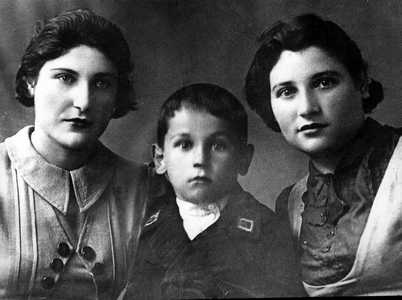 Fima Galper and his elder sisters,
Fima Galper and his elder sisters,Fanya and Zina, natives of Seliba. The father, Tevel Haimovich, and his family lived not far from Seliba, in the village of Bortsy before the revolution. It was a typical Russian or Belarusian village. There lived real bandits who robbed people on the roads. My grandfather had four sons and three daughters. After 1919, Belarus was occupied by the White Poles, who organized Jewish pogroms. The grandfather was shot, and my father was wounded in the leg. He had just got married and had two small daughters, Fanya and Zina, born in 1921 and 1922. They were my stepsisters. My father’s first wife was my mother's sister. She was very sick. She had a heart disease. In 1930, she died, my father married again, and my mother brought up his daughters. They became very good doctors. My father was a master of all trades. He had to help his father, who ran a small shop or tavern, where he had the right to sell alcoholic beverages. My father had to drift logs down the Berezina river, and he told me how he accompanied rafts for twenty kilometers. Actually, he and his two brothers were very strong men of athletic build. When life got very hard, my father gathered his brothers, sisters, grandfather and grandmother and illegally ferried them to Poland, and from there they moved to the United States. Even in 1868, my father’s elder brother, Iosif, went there to find a job. Now, all my uncles and aunts are dead, but we kept in touch with them, exchanged letters, they came here, and my wife and I went to visit them in the United States. Their children and grandchildren live as a very large family, about 80 people. 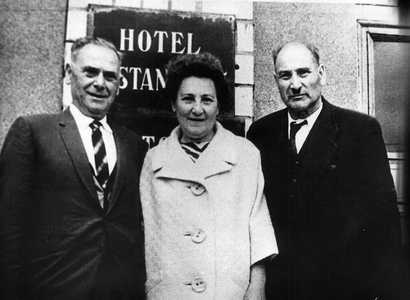 Tevel Haimovich Galper
Tevel Haimovich Galperand his American relatives. When we visited them in 1990, we were introduced to 50 family members. And now, in New York there is a large construction company, “Galper and Son”, founded by my father’s brother, Iosif, or Joseph. Our relatives came to the Soviet Union three times: in the 1960s, 1970 and 1980. My father never wanted to be dependent from anybody. It was his credo. He asked Joseph, his American brother, owner of 33 multi-storey buildings with luxury apartments and doorkeepers: “Now, if I move, will you give me an apartment?” He replied: “No, I'll grant you on lease. But as you are my brother, I will not raise the rent. But, if you haven’t got enough money, I will, of course, add.” My father says: “So, I’ll have to borrow money from you every month. I don’t want to live like that.” So he did not go anywhere. Some of his brothers and sisters were able to get education and become productive members of the American society. My father’s brother, Leiba, became an engineer, Haifa and Belka, however, worked in a laundry, but Nema happily married a very wealthy man. Their children and grandchildren are well-known people. They got one, or even two educations, became doctors, engineers, economists. My father remained in the village. He returned to his wife and children. As I said, my father had done a lot of different jobs in his life. Once he got interested in trade, took a loan and bought a large store. It happened at the time of the New Economic Policy. One of the uncles on my mother's side, Tsodik, was fond of Zionist ideals. He was a member of the Jewish organization “Poalei Zion”. My father also joined the organization. Naturally, the ideas of “Poalei Zion” were not in line with the Bolsheviks and the organization members were sent into exile to the Arkhangelsk region. It was in 1927. At that time my father’s first wife died. By the way, we got to know the story much later. All the time we believed that he had left to find a job, to timber stockpiling, leaving his wife and small children. But things were different. My father was not even allowed to come to his wife’s funeral. Some time later, he was released, returned home and married my mother. 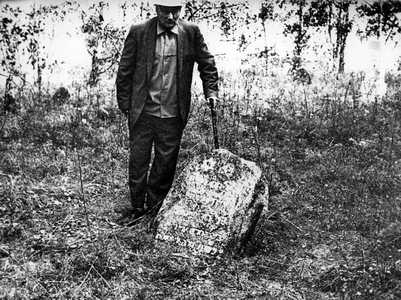 Tevel Haimovich Galper at his father’s grave.
Tevel Haimovich Galper at his father’s grave.
In 1933 we moved to Mogilev. My father decided to take up fine art photography. As far as I know, he created his studio himself. He always believed that everyone should have their business and must be independent. We can say that he was a born entrepreneur. Probably, in a free world, he would have become a very tough businessman. He wasn’t literate enough, but as far as entrepreneurship is concerned, he was very good. By the way, my uncle Joseph had never learned to read and write in English, but it didn’t stop him from launching and succeeding in his business. My father finished heder, could read and write in Yiddish and, as I understand it, he knew Hebrew, as he read the Bible. We used to gather on Jewish holidays, and he always read a prayer before the meal. He worked until retirement in 1961. Describing him more broadly, I should say that he was a very handsome man, tall and strong. I think that when he was walking along the village, many girls liked him. Many years later, somewhere in 1969, there was a telephone call from Riga. A woman spoke English and asked to talk to Tevie. At that time my father had a broken hip, and he was in bed. We explained it to the woman, but she insisted on talking to Tevie. She said that she wanted to see him very much and she came from the United States specially for that purpose. We agreed that my wife and sister would go to Riga to see her. They were met by a very old lady, nice and good-looking. When she saw us, she began to cry and said that she had lived all her life in America and wanted to see Tevie, who she was so much fond of. Then the old woman told us her story. She was married four times, lived in Baltimore and remembered Tevie, who she had met in Belarus. And then, feeling that soon she would pass away, she came specially to see him. The meeting was brief and a few days later she called to Mogilev again, and they had a long talk in Yiddish with my father. Later my father told me that when he was a young man, he walked for 20 km on a date with that girl. Memories recorded, photos by
|
|||
|
|
Jewish settlements in Minsk regionMinsk • Berezino • Bobr • Borisov • Dolginovo • Dukora • Dzerzhinsk • Ivenets • Myadel • Nesvizh • Obchuga • Pogost • Rakov • Seliba • Slutsk • Svir • Uhvaly • Vileika • |
Main |
New publications |
Contacts |
Site map |
Vitebsk region |
Mogilev region |
Minsk region |